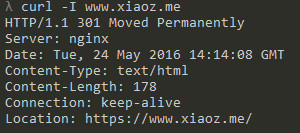Nginx Force HTTPS, HTTP 301 Redirect to HTTPS
Publish: 2016-05-24 | Modify: 2018-11-04
Enable HTTPS for Your Website
Enabling HTTPS for your website can make it more secure. In this article, we will share a method to redirect all HTTP requests to HTTPS by configuring the web server (Nginx) directly, without making too many changes to the program settings. This method is currently used by XiaoZ's blog.

Prerequisites
This method is only applicable to the Nginx web server. We recommend installing LNMP or OneinStack, or you can also compile and install Nginx on your own.
Modify the Host Configuration File
For LNMP or OneinStack, the configuration file is located at /usr/local/nginx/conf/vhost/yourdomain.com.conf. Add the following configuration to the file:
server
{
listen 80;
server_name xiaoz.me www.xiaoz.me;
rewrite ^(.*) https://blog.xiaoz.org$1 permanent;
}The above configuration means that when we use HTTP to request xiaoz.me or www.xiaoz.me, it will be redirected to https://blog.xiaoz.org. Below is a complete configuration file for reference:
server {
listen 443;
ssl on;
ssl_certificate /data/ssl/xiaoz.me.crt;
ssl_certificate_key /data/ssl/xiaoz.me.key;
server_name xiaoz.me www.xiaoz.me;
index index.html index.htm index.php;
...
...
}
server
{
listen 80;
server_name xiaoz.me www.xiaoz.me;
rewrite ^(.*) https://blog.xiaoz.org$1 permanent;
}After modifying the configuration, don't forget to reload Nginx: service nginx reload.
CURL Test
Finally, we can test whether accessing HTTP will be redirected to HTTPS. You can use CURL to test it: curl -I www.xiaoz.me. For a tutorial on configuring SSL for Nginx, you can refer to How to Deploy SSL Certificate for Nginx.

Recommended Reading:
Comments

xiaoz
I come from China and I am a freelancer. I specialize in Linux operations, PHP, Golang, and front-end development. I have developed open-source projects such as Zdir, ImgURL, CCAA, and OneNav.
Random article
- I Chopped My Hand Off on Double 11 and Bought These Electronics (Standing Desk, Monitor, etc.), Let's Chat About It?
- Mr. K's Journey as a Programmer
- Multi-functional File Sharing Program Zdir 4.2.1 Released, Come Claim Your Free Zdir Pro Subscription
- Turn off All in one SEO auto description to avoid duplicate descriptions
- Nginx Reverse Proxy + Thumbor Image Cropping: Enhancing Nginx's Image Cropping Support
- Tutorial on how to unlock Huawei Honor 4 Play Edition
- Create Your Personal Movie Library with Netease Filmly Video Player
- OneNav Bookmark Management Program 0.9.24 Update: Now Subscriptions Only $19.9/Year
- Purchase Msimple Theme
- The Complete Process of Configuring SSL Certificate for Old Xue's Host